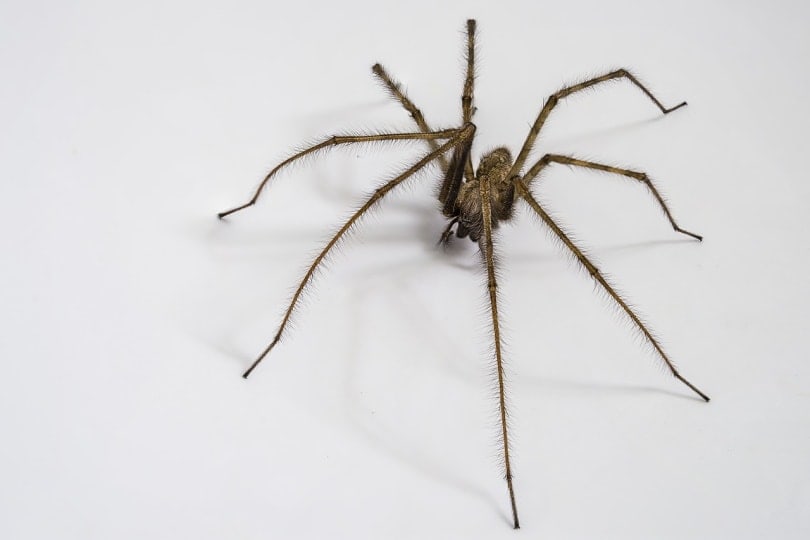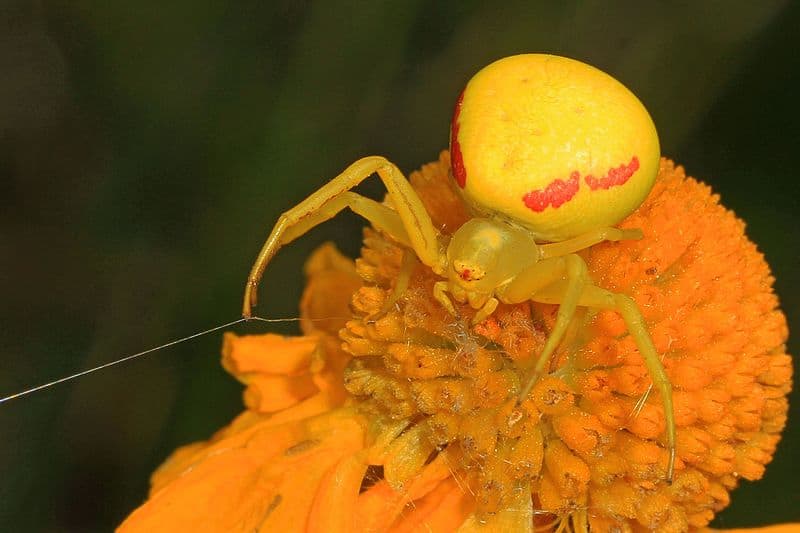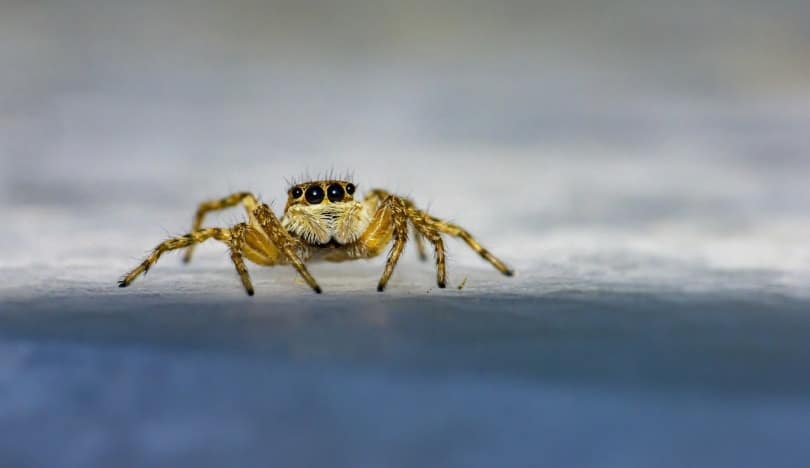There are currently about 500 species of spiders residing in Oregon. With so many spiders living in such a large state, it’s common to wonder if any poisonous spiders are living among us. Some spiders are venomous, which means that they will inject their toxin into their prey. Most spiders living in Oregon are harmless because their fangs are too small to bite humans, or their venom will have little to no effect on the average person. The one exception is the western black widow spider. Read on to learn about the most common spiders you’ll find in Oregon.

The 5 Spiders Found in Oregon
1. Western Black Widow Spider

| Species: | Latrodectus hesperus |
| Longevity: | 1 – 3 years |
| Good to own as a pet?: | No |
| Legal to own?: | Unknown |
| Adult size: | .25 – 1 inch |
| Diet: | Carnivorous |
The western black widow spider is the only venomous spider living in Oregon. It is mostly found in the southwestern and eastern parts of the state. Occasionally this spider is found in the northwestern part of the state, but those sightings are rare. The females are black with the well-known red hourglass shape on the underside of the abdomen. Males of the species are usually brown and green with orange markings on their bodies.
This notorious arachnid likes to live in abandoned animal burrows, woodpiles, and garages. Their webs are usually irregular in appearance and often look like cobwebs. Their diet consists of a variety of insects, including ants, cockroaches, beetles, and more.
Bites usually occur when a human hand accidentally ventures into the Black Widow’s domain. Symptoms of a bite include headache, vomiting, and muscle pain. Schedule a medical appointment immediately to get checked out if you’ve been bitten by a black widow spider.
2. Hobo Spider

| Species: | Eratigena agrestis |
| Longevity: | 1 – 3 years |
| Good to own as a pet?: | No |
| Legal to own?: | Unknown |
| Adult size: | Body up to .06 inches; legs up to 2 inches |
| Diet: | Carnivorous |
The next spider on the list is the hobo spider, which gets its name from the fact that is it often found near railroad tracks. This spider has a brown body with darker brown markings on the legs with yellow markings in a chevron pattern on the underside of the abdomen. They like to nest in yards and under rocks but may occasionally find their way indoors. Hobo spiders build a funnel-like web and scurry out to draw in any insects that get caught in the mouth of their web.
The bite of the hobo spider used to be considered venomous in the 1980s. Over the last thirty years, there have been no significant medical cases of hobo spider bites and the CDC removed the arachnid from its list of dangerous spiders in 2017. The spider may bite if provoked, but most reactions to the bite will be minor.
3. Giant House Spider

| Species: | Eratigena atrica |
| Longevity: | 2 – 6 years |
| Good to own as a pet?: | No |
| Legal to own?: | Unknown |
| Adult size: | Body .047 – .073 inches; legs up to 3 inches |
| Diet: | Carnivorous |
Giant house spiders are common spiders found in Pacific Northwest homes. While the head and legs of this spider are typically a reddish-brown to dark brown, the abdomen is smaller and light-colored, often yellow-brown, or gray color with a chevron-like pattern in black. This pattern is common among spider species and often leads to confusion because the giant house spider and hobo spider share similar body characteristics.
This large spider builds webs that look like funnels in corners or near the ceiling, but they usually prefer basements to avoid human interaction. Their diet consists of the insects they catch in their web, which can include moths, flies, and wasps. These spiders are well-known for being extremely fast and would rather run away than bite humans or pets. A bite from a giant house spider should only result in irritation to human skin.
4. Zebra Spiders

| Species: | Salticus scenicus |
| Longevity: | 2 – 3 years |
| Good to own as a pet?: | No |
| Legal to own?: | Unknown |
| Adult size: | 0.25 inches or smaller |
| Diet: | Carnivorous |
The zebra spider, also known as the zebra jumping spider, is known for the same distinctive white and black coloring as its’ namesake. They can often be found on vertical surfaces, such as windows, fences, and walls. The zebra spider has large eyes that allow it to form detailed images to track movement for mating and hunting. These small spiders do not use webs to capture their prey, but rather jump on their prey and immobilize it with venom before eating. The spider eats mosquitoes, flies, and even smaller spiders.
During the mating season, the male zebra spider waves his legs and performs a zigzagging dance. The female watches the dance and if she determines the male is worthy, she crouches down for mating. If she doesn’t like his dance, well… her annoyance with him means he’ll make a tasty dinner. You won’t get eaten by this spider if you annoy it, but if you do get bit, you’ll likely only encounter mild irritation.
5. Goldenrod Crab Spider

| Species: | Misumena vatia |
| Longevity: | 2 years |
| Good to own as a pet?: | No |
| Legal to own?: | Unknown |
| Adult size: | 0.12 to 0.35 inches |
| Diet: | Carnivorous |
The goldenrod crab spider is an arachnid many Oregon gardeners will be familiar with as it makes its’ home on flowers, vegetation, and fences. These small spiders have long front legs that they hold open to grab their prey, which gives them a crab-like appearance. The females are distinctive in that they vary from white to yellow with red markings on the side of the abdomen.
The females can also change color from white to yellow over time to blend in with the flowers to easily catch bees, butterflies, flies, and more. The males are usually reddish-brown with the first two sets of legs being a similar color, while the last two sets are usually yellow. The male abdomen is usually white with red markings. A bite from a goldenrod crab spider may cause some discomfort, but it shouldn’t have any lasting effect on you.

What About Brown Recluse Spiders?

Anyone who lives in Oregon has heard the story that a friend of a friend of a friend who got bit by a brown recluse spider. We’ll put your mind at ease right now and tell you that, despite reports to the contrary, the brown recluse does not live in Oregon.
The brown recluse spider, or loxosceles reclusa, is often found hiding in bark, under rocks, or in barns, houses, and sheds. The spider is about a ½-inch in size and has a distinctive violin shape on the abdomen. The brown recluse and the hobo spider have similar coloring, which often leads to the belief in Oregon that someone has seen a brown recluse spider instead of the harmless hobo spider. On the rare occasion that the brown recluse spider bites a human, the venom injected causes tissue deterioration.
This spider prefers the warmer climates of the southern states, and some parts of the Midwest, and is unlikely to be found in Oregon.

Conclusion
While there are over 500 species of spiders in Oregon, most of them are harmless to humans and pets. A bite from the western black widow spider can be painful and should be checked out by a doctor. Although many people fear spiders due to their appearance, the spiders residing in Oregon provide a valuable service to the state’s ecosystem by keeping other insects in check. If you’re concerned about spiders in your home, install window screens, seal any cracks from the outside, and wipe away webs from railings, porches, and light fixtures. Overall, there is no need to fear if you receive a bite from a spider in Oregon.
- Related read: 11 Spiders Found in Maine (with Pictures)
Featured Image Credit: Eric_Karits, Pixabay
